science

For most of history, psychologists thought of the study of siblings as backwater: Parenting was important — siblings were not.
Then in the 1980s, a researcher named Robert Plomin published a surprising paper in which he reviewed the three main ways psychologists had studied siblings: physical characteristics, intelligence and personality. According to Plomin, in two of these areas, siblings were really quite similar.
Physically, siblings tended to differ somewhat, but they were a lot more similar on average when compared to children picked at random from the population. That’s also true of cognitive abilities.
“The surprise,” says Plomin, “is when you turn to personality.”
Turns out that on tests that measure personality — stuff like how extroverted you are, how conscientious — siblings are practically like strangers.
In fact, in terms of personality, we are similar to our siblings only about 20 percent of the time. Given the fact that we share genes, homes, routines and parents, this makes no sense. What makes children in the same family so different? (…)
No one knows for sure, but there are three major theories.
{ NPR | Continue reading }
photo { Katie Shapiro }
mystery and paranormal, psychology | November 29th, 2010 7:05 pm

Research conducted by a UCLA behavior lab found that women tend to avoid their fathers during periods of peak fertility, suggesting an evolutionary adaptation against inbreeding in humans. An examination of cell phone records found that ovulating women were half as likely to engage in conversation with their fathers and spoke to them for half as long than during low fertility periods. (…)
The reluctance to engage in conversations with fathers could not be attributed to an impulse to avoid all parental control during ovulation. In fact, the researchers found that women actually increased their phone calls to their mothers during this period of their cycle.
{ University of California Newsroom | Continue reading }
photo { Logan White }
relationships, science | November 29th, 2010 6:39 pm

Humans are known to play it safe in a situation when they aren’t sure of the odds, or don’t have confidence in their judgments. We don’t like to choose the unknown.
And new evidence from a Duke University study is showing that chimpanzees and bonobos, our closest living primate relatives, treat the problem the same way we do.
In studies conducted at the Tchimpounga Chimpanzee Sanctuary in Republic of Congo and Lola ya Bonobo Sanctuary in Democratic Republic of Congo, researchers found the apes prefer to play it safe when the odds are uncertain.
{ EurekAlert | Continue reading }
related { Neuroscience of instinct: How animals overcome fear to obtain food }
photo { Matthew Farrant }
animals, science | November 29th, 2010 6:39 pm

The discovery that natural clay forms a protective shell around tiny air bubbles has profound implications for our theories about the origin of life on Earth.
One of the great mysteries in biology is the origin of cell membranes, the protective layers that completely surround the complex chemical soup in which many of life’s most delicate processes take place.
DNA and its attendant biochemical machinery can only operate in the carefully controlled environment that the cell membrane creates. But curiously, one of the important jobs that this machinery does is to create the chemical building blocks that then self-assemble into the membrane itself. So that creates a paradox: the membrane cannot form without the biochemical machinery but this will not work without the protection of the cell membrane.
The puzzle is which came first. How could cell membranes have evolved without biochemical machines to manufacture the building blocks? And alternatively, how could the biochemical machines have evolved without the crucial protection that cell membranes provide? It’s a chicken and egg problem.
In recent years, an answer has emerged. It very much looks as if the cell membranes came first and the evidence comes from numerous studies that show how simple organic molecules can self-assemble into bubble-like structures called vesicles.
Various groups have shown how these vesicles can form not only in the prebiotic soup that probably existed early in Earth’s history but also on the surface of ultracold crystals that we know to exist in interstellar space.
By this way of thinking, the vesicles provided a protective environment in which the molecules of life slowly evolved.
Today, we get another option. Anand Bala Subramaniam at Harvard University and a few pals have discovered that this process of vesicle formation also happens in a naturally occurring clay called montmorillonite. That’s the kind of stuff that might clogg your boots after a hike.
{ The Physics arXiv Blog | Continue reading }
artwork { Dominic McGill }
mystery and paranormal, science | November 29th, 2010 6:10 pm

A Wandering Mind Is an Unhappy Mind
We developed a smartphone technology to sample people’s ongoing thoughts, feelings, and actions and found (i) that people are thinking about what is not happening almost as often as they are thinking about what is and (ii) found that doing so typically makes them unhappy.
{ ScienceMag }
photo { Cyril Lagel }
psychology, technology | November 29th, 2010 4:07 pm
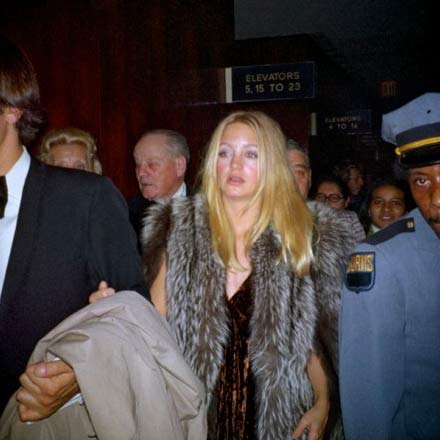
When people are anxious they release a chemical signal that’s detectable on a subconscious level by those close to them. That’s the implication of a new study that collected sweat from people as they completed a high-rope obstacle course, and then tested the effect of that sweat on study participants as they played a gambling game.
Katrin Haegler’s team placed the sweat samples inside odourless tea bags which were attached with an elastic band to the underside of the gambling participants’ noses. For comparison, the participants were also exposed to sweat collected from non-anxious riders of an exercise bike.
When exposed to the anxious sweat, the participants took longer to decide over, but were more likely to bet on the highest risk scenarios. (…) In other words, the detection of another person’s anxiety made them more willing to take risks. Quite why this should be remains unclear.
{ BPS | Continue reading }
photo { Gary Lee Boas }
mystery and paranormal, olfaction, psychology | November 28th, 2010 12:05 pm

Blue space: The importance of water for preference, affect, and restorativeness ratings of natural and built scenes
Although theorists have suggested that aquatic environments or “blue space” might have particular restorative potential, to date there is little systematic empirical research on this issue. (…)
Whereas aquatic features (rivers, lakes, coasts) are frequently present in visual stimuli representing natural environments they are rarely incorporated in stimuli portraying built environments. (…)
The current research collated a set of 120 photographs of natural and built scenes, half of which contained “aquatic” elements. Proportions of “aquatic”/“green”/“built” environments in each scene (e.g. 1/3rd, 2/3rds) were also standardised. (…)
As predicted, both natural and built scenes containing water were associated with higher preferences, greater positive affect and higher perceived restorativeness than those without water.
{ Science Direct }
photo { Harri Peccinotti, Pirelli Calendar, 1969 }
psychology, water | November 28th, 2010 12:00 pm

The universe seems vast, distant, and unknowable. It is, for example, unimaginably large and old: The number of stars in our galaxy alone exceeds 100 billion, and the Earth is 4.5 billion years old. In the eyes of the universe, we’re nothing. (…)
Clearly, our brains are not built to handle numbers on this astronomical scale. While we are certainly a part of the cosmos, we are unable to grasp its physical truths. (…) However, there actually are properties of the cosmos that can be expressed at the scale of the everyday. (…)
It turns out that there is one supernova, a cataclysmic explosion of a star that marks the end of its life, about every 50 years in the Milky Way. The frequency of these stellar explosions fully fits within the life span of a single person, and not even a particularly long-lived one. So throughout human history, each person has likely been around for one or two of these bursts that can briefly burn brighter than an entire galaxy.
On the other hand, while new stars are formed in our galaxy at a faster rate, it is still nice and manageable, with about seven new stars in the Milky Way each year. So, over the course of an average American lifetime, each of us will have gone about our business while nearly 550 new stars were born.
{ Boston Globe | Continue reading }
photo { 美撒guo }
ideas, science, space | November 28th, 2010 10:45 am

What is 357 times 289? No pencils allowed. No calculators. Just use your brain. (…)
The brain is, in the words of neuroscientist Floyd Bloom, “the most complex structure that exists in the universe.” Its trillions of connections let it carry out all sorts of sophisticated computations in very little time. You can scan a crowded lobby and pick out a familiar face in a fraction of a second, a task that pushes even today’s best computers to their limit. Yet multiplying 357 by 289, a task that demands a puny amount of processing, leaves most of us struggling.
For psychologists, this kind of mental shortcoming is like a crack in a wall. They can insert a scientific crowbar and start to pry open the hidden life of the mind. The fact that we struggle with certain simple tasks speaks volumes about how we are wired. It turns out the evolution of our complex brain has come at a price: Sometimes we end up with a mental traffic jam in there.
{ Discover | Continue reading }
photo { RJ Shaughnessy }
brain, science | November 26th, 2010 4:50 pm

I wondered for probably the millionth time why I am always running late.
This time, I vowed, I was going to find out.
I turned to an obscure field of neuroscience for answers. The scientists who work on the problem of time in the brain sometimes refer to their area of expertise as “time perception” or “clock timing.” What they’ve discovered is that your brain is one of the least accurate time measurement devices you’ll ever use. And it’s also the most powerful.
When you watch the seconds tick by on a digital watch, you are in the realm of objective time, where a minute-long interval is always 60 seconds. But to your brain, a minute is relative. Sometimes it takes forever for a minute to be over. That’s because you measure time with a highly subjective biological clock.
Your internal clock is just like that digital watch in some ways. It measures time in what scientists call pulses. Those pulses are accumulated, then stored in your memory as a time interval. Now, here’s where things get weird. Your biological clock can be sped up or slowed down by anything from drugs to the way you pay attention. If it takes you 60 seconds to cross the street, your internal clock might register that as 50 pulses if you’re feeling sleepy. But it might register 100 pulses if you’ve just drunk an espresso. That’s because stimulants literally speed up the clock in your brain (more on that later). When your brain stores those two memories of the objective minute it took to cross the street, it winds up with memories of two different time intervals.
And yet, we all have an intuitive sense of how long it takes to cross a street. But how do we know, if every time we do something it feels like it a slightly different amount of time? The answer, says neuroscientist Warren Meck, is “a Gaussian distribution” - in other words, the points on a bell curve. Every time you want to figure out how long something is going to take, your brain samples from those time interval memories and picks one. (…)
Your intuitive sense of how much time something will take is taken at random from many distorted memories of objective time. Or, as Meck puts it, “You’re cursed to be walking around with a distribution of times in your head even though physically they happened on precise time.”
Your internal clock may be the reason why you can multitask. Because nobody - not even the lowly rat - has just one internal clock going at the same time.
At the very least, you’ve got two internal clocks running. One is the clock that tracks your circadian rhythms, telling you when to go to sleep, wake up, and eat. This is the most fundamental and important of all your internal clocks, and scientists have found it running even in organisms like green algae. The other clock you’ve likely got running is some version of the interval time clock I talked about earlier - the one that tells you how long a particular activity is going to take.
{ io9 | Continue reading }
photo { Logan White }
neurosciences, time | November 26th, 2010 4:48 pm

Circular patterns within the cosmic microwave background suggest that space and time did not come into being at the Big Bang but that our universe in fact continually cycles through a series of “aeons.” That is the sensational claim being made by University of Oxford theoretical physicist Roger Penrose, who says that data collected by NASA’s WMAP satellite support his idea of “conformal cyclic cosmology”. This claim is bound to prove controversial, however, because it opposes the widely accepted inflationary model of cosmology.
According to inflationary theory, the universe started from a point of infinite density known as the Big Bang about 13.7 billion years ago, expanded extremely rapidly for a fraction of a second and has continued to expand much more slowly ever since, during which time stars, planets and ultimately humans have emerged. That expansion is now believed to be accelerating and is expected to result in a cold, uniform, featureless universe.
Penrose, however, takes issue with the inflationary picture and in particular believes it cannot account for the very low entropy state in which the universe was believed to have been born – an extremely high degree of order that made complex matter possible. He does not believe that space and time came into existence at the moment of the Big Bang but that the Big Bang was in fact just one in a series of many, with each big bang marking the start of a new “aeon” in the history of the universe.
{ PhysicsWorld | Continue reading }
related { In an experiment to collide lead nuclei together at CERN’s Large Hadron Collider physicists discovered that the very early Universe was not only very hot and dense but behaved like a hot liquid. }
photo { Young Kyu Yoo }
related:
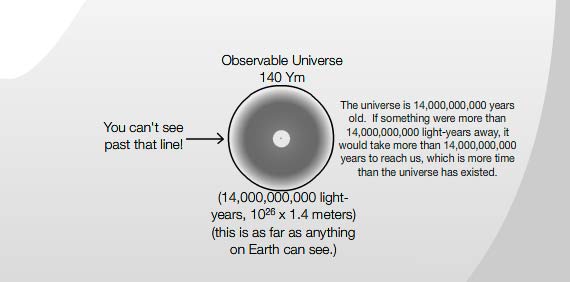

{ The Scale of the Universe }
space, theory, time | November 26th, 2010 4:20 pm
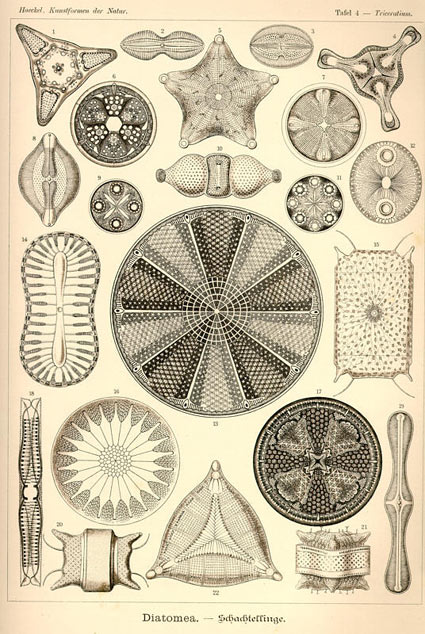
{ Ernst Haeckel, Kunstformen der Natur, 1899-1904 | Ernst Haeckel (1834 – 1919) was an eminent German biologist, naturalist, philosopher, physician, professor and artist who discovered, described and named thousands of new species, mapped a genealogical tree relating all life forms, and coined many terms in biology, including ecology. | Wikipedia | Continue reading }
Linguistics, flashback, science, visual design | November 26th, 2010 4:20 pm

In the 1940s, the Dutch psychologist Adrian de Groot performed a landmark study of chess experts. Although de Groot was an avid chess amateur – he belonged to several clubs - he grew increasingly frustrated by his inability to compete with more talented players. De Groot wanted to understand his defeats, to identify the mental skills that he was missing. His initial hypothesis was that the chess expert were blessed with a photographic memory, allowing them to remember obscure moves and exploit the minor mistakes of their opponents.
De Groot’s first experiment seemed to confirm this theory: He placed twenty different pieces on a chess board, imitating the layout of a possible game. Then, de Groot asked a variety of chess players, from inexperienced amateurs to chess grandmasters, to quickly glance at the board and try to memorize the location of each piece. As the scientists expected, the amateurs drew mostly blanks. The grandmasters, however, easily reproduced the exact layout of the game. The equation seemed simple: memory equals talent.
But then de Groot performed a second experiment that changed everything. Instead of setting the pieces in patterns taken from an actual chess game, he randomly scattered the pawns and bishops and knights on the board. If the best chess players had enhanced memories, then the location shouldn’t matter: a pawn was still a pawn. To de Groot’s surprise, however, the grandmaster edge now disappeared. They could no longer remember where the pieces had been placed.
For de Groot, this failure was a revelation, since it suggested that talent wasn’t about memory – it was about perception. The grandmasters didn’t remember the board better than amateurs. Rather, they saw the board better, instantly translating the thirty-two chess pieces into a set of meaningful patterns. They didn’t focus on the white bishop or the black pawn, but instead grouped the board into larger strategies and structures, such as the French Defense or the Reti Opening.
This mental process is known as “chunking” and it’s a crucial element of human cognition. As de Groot demonstrated, chess grandmasters automatically chunk the board into a set of known patterns, which allow them to instantly sort through the messy details of the game. And chunking isn’t just for chess experts: While reading this sentence, your brain is effortlessly chunking the letters, grouping the symbols into lumps of meaning. As a result, you don’t have to sound out each syllable, or analyze the phonetics; your literate brain is able to skip that stage of perception. This is what expertise is: the ability to rely on learned patterns to compensate for the inherent limitations of information processing in the brain. As George Miller famously observed, we can only consciously make sense of about seven bits of information (plus or minus two) at any given moment. Chunking allows us to escape this cognitive trap.
{ Wired | Continue reading }
brain, chess, memory, neurosciences | November 26th, 2010 4:15 pm

Light is special. In our everyday experience it behaves like a wave, which gets reflected, refracted and shows interference with other light of the same wavelength.
At the same time, light also consists of particles, so-called photons.
This duality is quite fundamental: the Hanbury Brown and Twiss experiment for example only works because of the particle-like properties of light.
This amazing and perhaps confusing duality, where light in one experiment appears to be a wave and in others it behaves like particles, is now laid bare in a paper published in Nature.
There, Jan Klaers, Martin Weitz and colleagues from the University of Bonn in Germany take one of the classical properties of light waves and turn it upside down — by demonstrating a related effect that only works when considering the particle qualities of light.
{ Joerg Heber | Continue reading }
photo { Valerie Chiang }
mystery and paranormal, science | November 24th, 2010 6:14 pm

The taste of the food and drinks that you serve your guests may impact their moral judgments of you in more ways than one. (…)
The results showed that taste perception significantly affected the study participants’ moral judgments — physical disgust, induced by a bitter taste, elicited feelings of moral disgust. This effect was more pronounced in participants with politically conservative views than in participants with liberal views. Taken together, these findings suggest that embodied gustatory experiences may impact moral processing more than previously thought.
{ APS | Continue reading }
food, drinks, restaurants, psychology | November 24th, 2010 5:26 pm

Have you ever heard a song on the radio that you recognize but you can’t pinpoint the name of the song? (…) It is common for people to recognize a song but how much or how little of the song do you need to hear to recognize it? Do you think you could recognize a song if you just heard a fragment of the song, the rhythm or if you just heard the notes played for you without any rhythmic information?
Kostic and Clearly conducted four different experiments to understand what parts of a song are essential for you to remember hearing it. (…)
The findings from this study reveal that there really is not just one aspect of a song that makes you recognize it as familiar. You can hear a distorted fragment of a song and recognize it. You can hear just the notes of the song played in order and recall that you heard the song before. You can hear the rhythm of the song and still remember it. Finally, you could hear the notes of a song played at a different speed and still recognize it. This speaks to the variety of things we attend to when we are listening to a song.
{ Cognition & the Arts | Continue reading }
sculpture { Iñigo Manglano-Ovalle, Cloud Prototype No.1, 2003 | fiberglass and titanium alloy foil }
music, science | November 24th, 2010 5:10 pm

A remote expedition to the deepest layer of the Earth’s oceanic crust has revealed a new ecosystem living over a kilometre beneath our feet. It is the first time that life has been found in the crust’s deepest layer, and an analysis of the new biosphere suggests life could exist lower still. (…)
They found communities of bacteria that were sparse but widespread. (…) This is similar to the bacteria found in oil reservoirs and contaminated soil, which could mean that the bacteria migrated down from shallower regions rather than evolving inside the crust, the team say.
{ NewScientist | Continue reading }
photo { Anthony Suau }
science | November 24th, 2010 4:25 pm
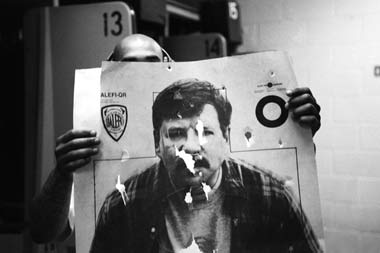
New York City in the 1920s and ’30s was a hotbed of criminal activity. Prohibition laws banning the production, sale and distribution of alcohol had been introduced, but instead of reducing crime, they had the opposite effect. Gangsters organized themselves and seized control of the alcohol distribution racket, smuggling first cheap rum from the Caribbean, then French champagne and English gin, into the country. Speakeasies sprang up in every neighbourhood, and numbered more than 100,000 by 1925. When prohibition was abolished in 1933, the gangsters took to other activities, such as drug distribution, and crime rates continued to increase.
At the forefront of the city’s efforts to keep crime under control was a man named Carleton Simon. Simon trained as a psychiatrist, but his reach extended far beyond the therapist’s couch. He became a ‘drug czar’ six decades before the term was first used, spearheading New York’s war against drug sellers and addicts. He was a socialite and a celebrity, who made a minor contribution to early forensic science by devising new methods to identify criminals. He also tried to apply his knowledge to gain insights into the workings of the criminal brain, becoming, effectively, the first neurocriminologist.
Simon was born in New York City on February 28th, 1871, and studied in Vienna and Paris, graduating with an M.D. in 1890. Afterwards, he conducted sleep research. (…) Eventually, Simon became interested in criminology and psychopathology, and by the turn of the century had abandoned his psychiatric research to focus on these disciplines. (…)
Towards the end of the 1930s crime was estimated to cost the U.S. approximately $15 billion annually. Knowledge of brain function and dysfunction was very rudimentary by today’s standards, and criminals and psychopaths were often lobotomized or subjected to electroconvulsive therapy in order to keep them under control. Another treatment available was insulin shock therapy, which had been introduced by Manfred Sakel in 1933, and involved giving patients large repeated doses of the hormone to induce coma. It was around this time that Simon proposed a new theory, which he believed would help science to understand and control the criminal mind.
The theory drew on the concept of cerebral dominance, which had emerged some 70 years earlier, largely from Paul Broca’s investigations of stroke patients. (…) According to Simon’s theory, criminality occurs as a result of a shift in cerebral dominance, whereby the normally submissive right hemisphere gains mastery of the brain, leading to irrational behaviour.
{ Neurophilosophy | Continue reading }
photo { Alessandro Zuek Simonetti }
flashback, neurosciences, new york, science | November 24th, 2010 4:10 pm

The fact that many bats utilize echolocation to find prey is well-known. This ability is well-developed; some bats even dynamically adjust the width of the sound pulse during the pursuit of prey, thereby broadening their field of view without sacrificing attention, useful for capturing erratically-flying prey.
In contrast, much less is known regarding how echolocating bats utilize sensory cues to recognize their habitat, an ability which is clearly important to their survival. (…)
Ornithologists have investigated how echolocating bats differentiate water, often a prominent feature of their habitat, from other surfaces. Their research demonstrates that echolocation is given prominence even in the face of contradictory sensory cues, and further suggests that this recognition ability is innate (not learned).
{ Behavioral Biology | Continue reading }
animals, science | November 24th, 2010 4:00 pm
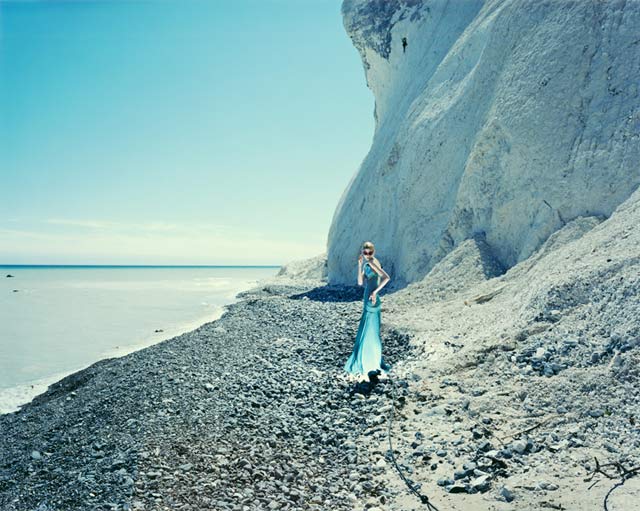
On October 25, family members of a 22-year old Malaysian woman reported her disappearance to police and that the woman had sent them a text message stating that she was being held captive by orang bunian (fairies).
This was not the first disappearance for Siti Balqis Mohd Noor. She had previously reported multiple “strange experiences” in which she apparently vanished into thin air and was later found in unexpected places, including the roof of her house, a nearby cement mixer, and a cemetery ten kilometers from her home. After all of these occurrences, Siti would report that she had no memory of what had happened.
{ Providentia | Continue reading }

NPR has a fascinating segment about how humans can’t walk in a straight line unless we have an external guide. We just end up walking in circles.
It turns out, no one is really sure why this happens but experiments on walkers, drivers and swimmers have all found the tendency to circle back on ourselves despite us thinking that we’re maintaining a steady course ahead.
{ Mind Hacks | Continue reading }
photos { Jean-François Lepage | Jeff P. Elstone II }
mystery and paranormal, photogs, science | November 23rd, 2010 4:55 pm

























